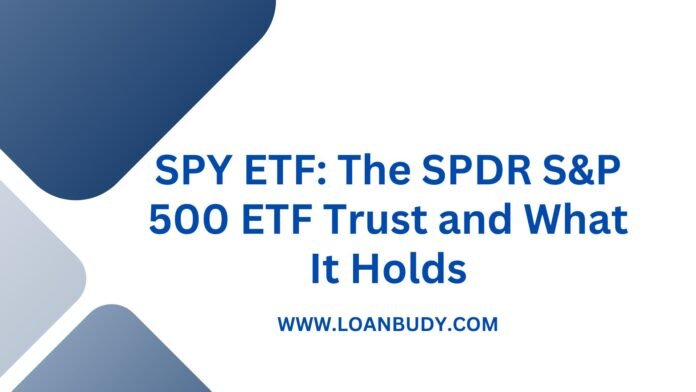Investing in the stock market can be daunting, especially for those new to the game. SPY ETF One popular option for investors looking to diversify their portfolios while gaining exposure to the overall market is the SPDR S&P 500 ETF Trust, commonly known as SPY. In this article, we’ll explore what the SPY ETF is, how it works, and what it holds, giving you a comprehensive understanding of this investment vehicle.
What is the SPY ETF?
The SPDR S&P 500 ETF Trust (NYSE: SPY) is an exchange-traded fund (ETF) that seeks to provide investment results that correspond to the performance of the S&P 500 Index. Launched in 1993, SPY is one of the oldest and largest ETFs in the world, making it a staple for many investors.
Key Features of SPY ETF
- Diversification: By holding shares of SPY, investors gain exposure to 500 of the largest publicly traded companies in the U.S., spanning various sectors, which helps reduce the risk associated with investing in individual stocks.
- Liquidity: SPY is one of the most traded ETFs, which means it generally has a high level of liquidity. This makes it easier for investors to buy and sell shares without significant price fluctuations.
- Cost-Effective: The expense ratio of SPY is relatively low compared to actively managed mutual funds, making it an attractive option for long-term investors.
How Does SPY ETF Work?
As an ETF, SPY operates similarly to a mutual fund, but with some key differences. Here’s how it works:
- Index Tracking: SPY aims to replicate the performance of the S&P 500 Index by holding the same stocks in similar proportions. This means that when the index goes up or down, SPY typically follows suit.
- Share Structure: When you invest in SPY, you’re buying shares of the ETF rather than individual stocks. Each share represents a fraction of the underlying assets held by the fund.
- Dividends: SPY also pays dividends, which are distributed to shareholders based on the income generated by the underlying stocks. These dividends can be reinvested or taken as cash.
What Does SPY Hold?
SPY’s portfolio is designed to reflect the S&P 500 Index, which includes companies from various sectors. Here’s a closer look at what it holds:
1. Sector Allocation
SPY’s holdings span across multiple sectors, including:
- Technology: This sector often comprises the largest portion of the ETF, featuring companies like Apple, Microsoft, and Alphabet.
- Health Care: Companies in pharmaceuticals, biotechnology, and health insurance make up a significant slice of SPY’s portfolio.
- Financials: Major banks and financial services companies are also well-represented.
- Consumer Discretionary and Staples: This includes companies ranging from retail giants to food and beverage brands.
- Utilities and Real Estate: These sectors provide stability and income through dividends.
2. Top Holdings
While SPY holds 500 stocks, a few key companies dominate its portfolio due to their larger market capitalizations. As of now, the top holdings often include:
- Apple Inc. (AAPL)
- Microsoft Corp. (MSFT)
- Amazon.com Inc. (AMZN)
- Berkshire Hathaway Inc. (BRK.B)
- Meta Platforms, Inc. (META)
These top five companies alone can account for a substantial portion of SPY’s total assets, illustrating the importance of understanding individual stock performance within the ETF.
Benefits of Investing in SPY
1. Market Exposure
Investing in SPY allows you to gain exposure to the broader U.S. stock market without the need to pick individual stocks. This makes it a great option for both new and experienced investors.
2. Passive Management
SPY is passively managed, which means it doesn’t try to beat the market but rather aims to match its performance. This strategy can often lead to lower fees and less trading activity.
3. Tax Efficiency
ETFs, including SPY, are generally more tax-efficient than mutual funds due to their unique structure, which minimizes capital gains distributions.
Considerations Before Investing
While SPY offers many advantages, it’s important to consider the following:
- Market Risk: Like any investment tied to the stock market, SPY carries market risk. Economic downturns can affect the value of the ETF.
- Sector Concentration: With a significant portion of its assets in technology, SPY may be more sensitive to fluctuations in that sector.
Conclusion
The SPDR S&P 500 ETF Trust (SPY) is a powerful investment tool that provides diversified exposure to the U.S. stock market. With its low expense ratio, high liquidity, and extensive holdings, SPY can be an excellent choice for investors looking to build a balanced portfolio. However, as with any investment, it’s crucial to assess your financial goals and risk tolerance before diving in. Understanding what SPY holds and how it operates will empower you to make informed decisions about your investment strategy.
Read More:
Understanding Earnings Per Share (EPS): What It Means and How to Calculate It
Forecasting: What It Is, How It’s Used in Business and Investing
College Se TC Lene Ke Liye Application Kaise Likhe












